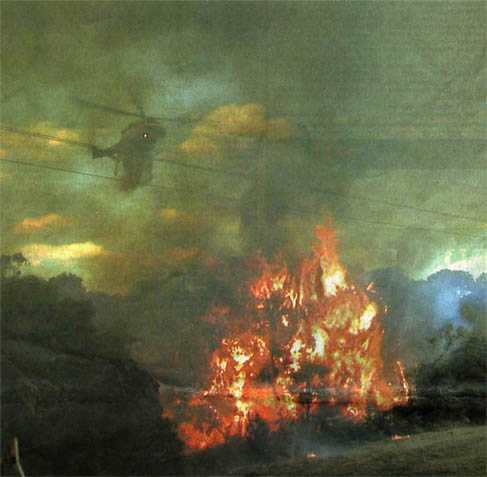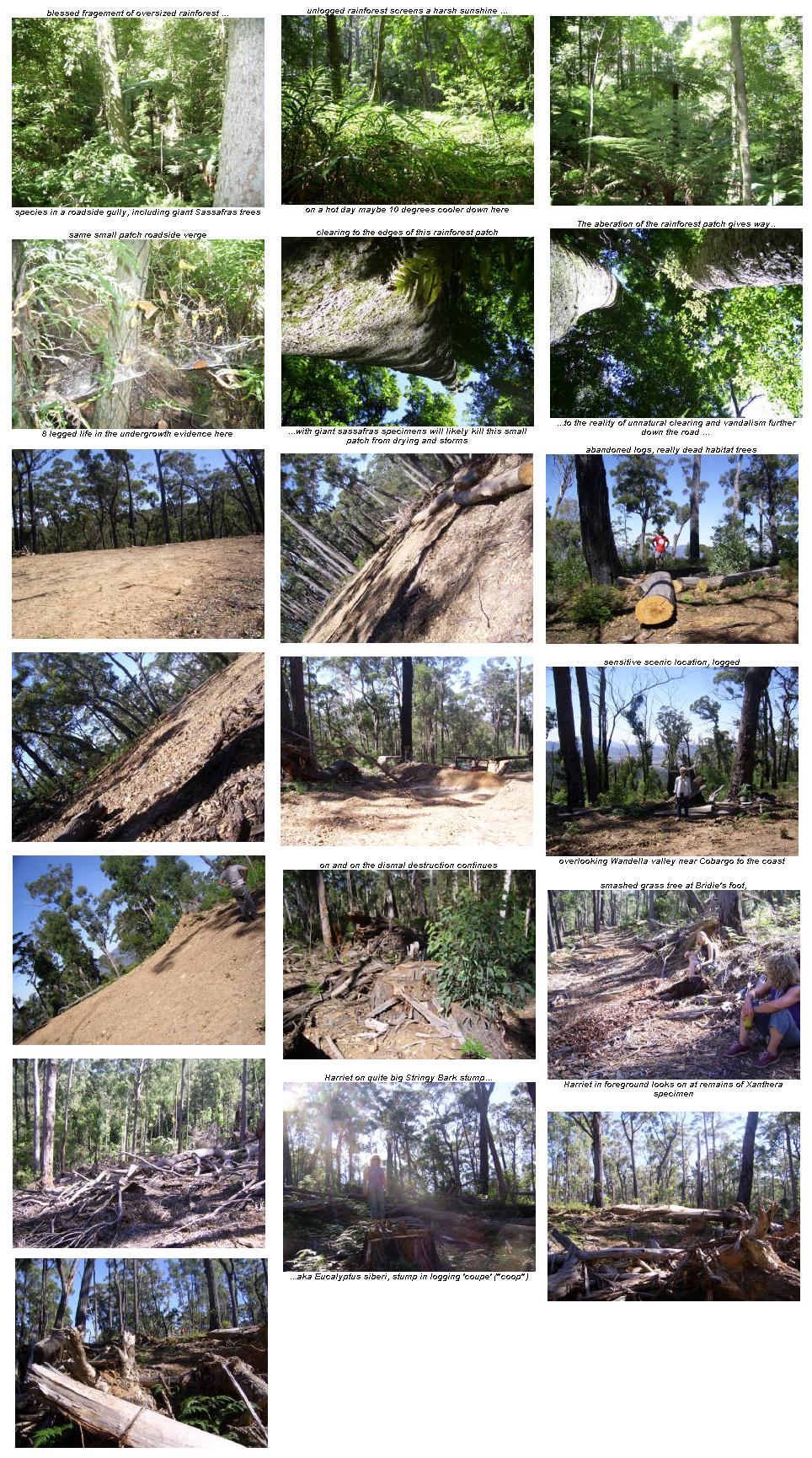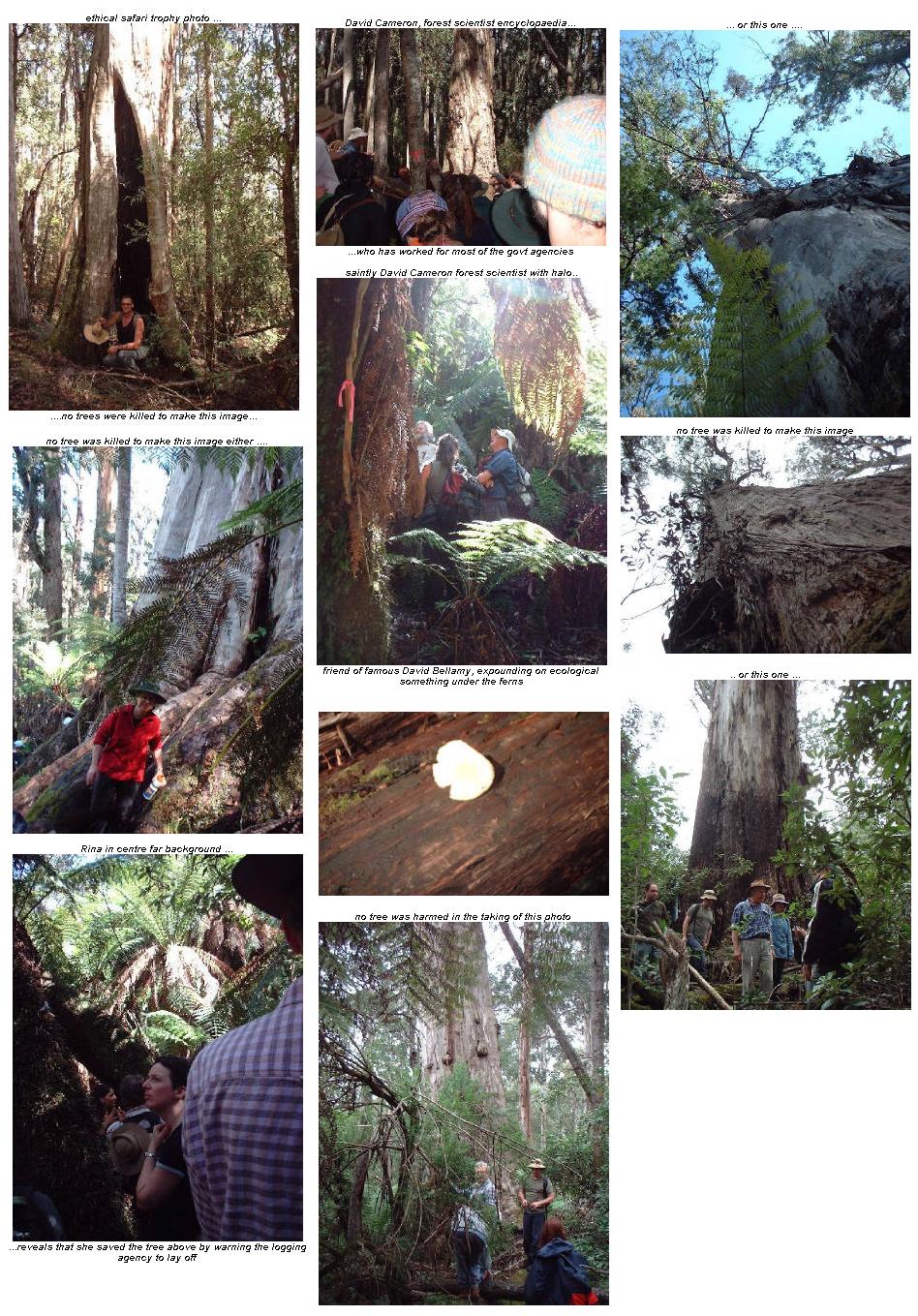Victorian bushfires: Rednecks project blame for their own 50 year logging legacy?
Topic: aust govt

Picture: A helicopter dumps water on the blaze along Kennedy Creek
Source Geelong Advertiser 13/1/00. In January/February 2000 two forest fires were started by bark heaps in logged forest catching alight in the Otways. These fires occurred at Kennedys Creek and Mount McKenzie Track. Many fires are apparently unreported by the media, as they are extinguished before they pose a serious threat
...................................
We wrote this comment recently on a long string in The Australian:
Most of these arguments are re-runs of the 1994 bushfires in NSW. The redneck know alls reckon fire only needs fuel and oxygen. WRONG. It also needs ignition. It also needs low moisture and/or humidity. So much for these one eyed experts.
Rainfall trend going down?: Leaf litter rots to soil in wet conditions quite fast. Ferals kill native grazers? Logging patchworked landscape makes for tinder dry schlerophyll instead of wet old growth (now barely 10 pc left after 50 years of mechanised logging).
I was called as state rep for The Wilderness Society to 2 inquiries Parliament and Coroners in NSW. I was shown the door because there was no case to answer. Nil. Zilch. Nada. None. 14 months later Carr was elected on forests.
I was elected 4 years local councilor. Quite right the govt carries the constitutional burden for 'peace, welfare and good government'. This is still a democracy for all voices until the policy decision is made by the elected. Packham and Wahlquist don't name a specific green/group. Why is that? How many Green Party councilors on Nillumbik? None?
The logging industry have more responsibility for wildfire than they know. Or they are in denial. The Blacks never disrupted forests like the D9 bulldozer etc.
This was in relation to these two stories:
Victoria bushfires stoked by green vote | The Australian Victoria bushfires stoked by green vote. Font Size: Decrease Increase; Print Page: Print. David Packham | February 10, 2009
and
Council ignored warning over trees before Victoria bushfires | The ... 11 Feb 2009
As suspected, our inconvenient comment has not been published which is why we saved it for archival record here for the more objective SAM readership.
And there is more like this today in one strand of malign prejudiced reportage. Not so surprising coming from allies of the logging industry whose business after all is death: Death of moist old growth forest and rainforest, death of native fauna with their poison baits for plantations, who are natural grazers of undergrowth and leaf litter, and death of water catchments for the export woodchip industry.
This is a legacy over more than a decade or two. This is a legacy of old growth extermination over 50 years or more. It's likely we can never regrow this cool wet old growth forest which take hundreds of years to establish and one logging season to destroy. We are now reaping as a society that 50 year legacy and kowtowing to the cynical logging industry and their political representatives of big corporations.
Bushfire scientist David Packham now retired (?) makes a bogus argument in the press today that "elements" of the green movement in Australia oppose essential prescribed burning and hazard reduction, "eco-terrorists waging jihad against prescribed burning and fuel management". Packham says they want to let the forest grow to close the canopy and create moist old growth. That's almost certainly a reference to our SAM article earlier this week. Only he deliberately misrepresents the article because that article refers to the spilt milk of conversion of existing moist old growth destroyed systemically over the last 50 years of highly mechanised logging.
No where do we say:
"They believe fundamentally that if we keep all fire out of Australia's forests, the trees will grow, the canopies will close up, the ground will become moist and there will be no fires. This is absolute and total nonsense."
What we said was that the logging industry has reversed the status quo of a closed canopy moist forest, and what's more it can be easily enough proved by the harvesting plans and volumes pulled out in the records held by the state agencies. We never said it could be re-created - a Packham fantasy apparently. You can almost see Packham frothing at the mouth as he levels this egregious misrepresentation. Not surprising given his 2003 submission here that without broadscale prescribed burning - possibly everywhere -"The hardwood timber industry will be obliterated". His bias is pretty obvious.
Here Packham is quoted approvingly in 2006 by a lcoal bushfire captain who seems to hates greenies (from the Cattleman's agenda to graze for free in national parks):
"There is little prospect of the serious fire risks being addressed from increasing fuel that threatens the safety of surrounding landholders, park visitors, water supplies and the timber industry. If this continues it will bring this state to its knees from lack of water and cause more destruction than any terrorist group is ever likely to do." [bold added]
The point is these folks have an axe to grind and are not objective. The bushfire captain goes on:
" On Tuesday and Wednesday 7 - 8 March 2006, two bushfire experts visited Wonnangatta at the request of Mountain Cattleman and members of the Licola Fire Brigade. David Packham has been a bushfire scientist for over 40 years including 8 years as Supervising Meteorologist for bushfire weather with the Bureau of Meteorology. Rod Incoll was the states former Chief Fire Officer." [bold added]
If Mr Packham and The Australian would like to specifically cross reference our SAM article we would be happy to commence defamation proceedings against him, speaking as a former commercial litigation lawyer. We will be happy to bankrupt the man for his opportunistic smears.
For instance we would be quoting this scientist:
1997....scientific refutation of the 'burn lots and burn often' simplistic approach allegedly used by pre European Aboriginal society
By John Benson of the Royal Botanic Gardens Sydney:
Abstract from "The nature of pre-European native vegetation south-eastern Australia" (condensed from J.S. Benson and RA. Redpath, Cunninghamia, 5(2) December, 1997)
"Based on a selection of quotes from early European explorers and settlers, it has been suggested that, at the time of European settlement of eastern Australia: the vegetation was mainly composed of grassland and grassy woodland; that Aborigines burnt most of the country every year or so; and a lack of fire after European settlement led to thick regrowth that was subsequently ringbarked and cleared by settlers for agricultural expansion. This overlooks the extensive scientific literature on past and present vegetation, and on fire ecology in Australia.
The claims of frequent burning mainly cover parts of south-eastern Australia between Tasmania and Brisbane, but do not deal with particular regions in a systematic way. They generally refer to one type of vegetation formation grassy woodland, which mainly occurs on clayey soils in drier coastal valleys, on non-siliceous soils on the undulating tablelands and on the western slopes. The explorers may have favoured travelling through these areas because they occur near rivers (water), had an open understorey and because some explorers were employed to seek out suitable grazing lands.
Using three historical estimates of tree density in grassy woodlands, we estimate there was an average of 30 large trees/ha spaced about one tree width apart. We found frequent references in the explorers' journals to vegetation containing a dense understorey including coastal heath, shrublands, rainforest and dense eucalypt forests. We found no evidence that most of south-east Australia's vegetation was annually burnt by Aboriginal people and provide examples where explorers' notes about fire have been misinterpreted or inappropriately extrapolated.
While some journal entries reveal that Aboriginal people used fire for cooking and burning the bush, the extent, frequency and season of their use of fire is largely unknown, particularly for southern Australia. Vegetation types such as rainforest, wet sclerophyll eucalypt forest, alpine shrublands and herbfields, and inland chenopod shrublands, along with a range of plant and animal species, would now be rarer or extinct if they had been burnt every few years over the thousands of years of Aboriginal occupation.
Furthermore, much evidence has been ignored that points to climate as being the main determinant in vegetation change over millions of years, with major changes occurring since the onset of aridity in the Miocene ( 24 to 5 million years ago) but continuing through the last ice age, which coincided with the occupation of Australia by Aboriginal people.
The adaptation of many plant species to aridity, drought, low nutrient soils and fire does not imply a requirement for them to be frequently burnt. South-eastern Australia's native vegetation is now highly fragmented, after 200 years of clearing, stock grazing and weed invasion. Management of what remains of this vegetation should be based on a scientific understanding of the functioning of ecosystems and the population dynamics of a range of plant and animal species."
By all means have prescibed burning even in old growth areas, as likely happened during Aboriginal tenure, but without the chainsaws, without the D9 bulldozers and without killing the canopy. There is no comparison of Aboriginal fire-stick practice and the last 50 years of the woodchip driven high intensity logging industry deliberately targeting the high volume forest giants and canopy for chips conversion to dry sclerophyll. As we explained it's spilt milk. The water cycle is damaged and probably irreparably.
The same article in The Australian effectively slimes The Wilderness Society, a non government green group, by the cute misrepresentation of the true technical definition of a wilderness (as per the 1987 NSW legislation): It's big - usually more than 20,000 hectares in size - unfragemented, and remote. To the general public the word could mean a local council park, national park or roadside verge at the bush town interface but that would be wrong. Wilderness areas are usually hundreds of kilometres from cities and towns or the risky bush-town interface. In those remote wilderness areas there is a case for limiting prescribed burning to only that required for essential protection of life and property.Which is usually minimal. It's quite distinct from other land tenures and the question of prescribed burning in buffer zones.
Similarly an opinion piece by a WA based 'expert' in The Australian today almost certainly misquotes TWS over a submission they made of 'massive increase in prescribed burning impact on ecology' to say the figures indicate no massive increase in "southern Australia". Only TWS is a national organisation, not just "southern Australia" and almost certainly are referring to unscientific let 'er rip burning in the Northern Territory: Such approaches probably increase wildfire risk not lessen it through promotion of fire-weeds and escaped hazard reduction burns. Never miss a chance to promote a misconception when you are a bigoted anti greenie.
All these points and statistical proof were made in 1994 by this writer after 700 bushfires ravaged NSW. And by the NSW NPWS. And they were accepted in the long drawn out process of reforming land use management accordingly in two official inquiries. NSW is now recognised as leading the pack in Australia as far as bushfire regulation goes.
When the truth comes out in the Royal Commission to be held in Victoria chances are most of the fires will have started and have burned on public roads, or private land and previously logged state forest. Very few will have started on national parks managed land and none or almost none will have occurred in properly identified wilderness areas.
But still these special wilderness areas are the last targets of the big corporate logging industry and the greens are the only obstacle between them and privatisation of that publicly owned natural heritage. In effect Packham and The Australian newspaper are feeding a smear campaign, seeking to leverage the shock and horror of the public at the very bad death toll of 300 in this latest tragedy. As we said the logging industry are practiced in the business of dealing in death.
This is the language of the extremist logging industry accusing their green opponents of 'eco-terrorist vandalism of logging machinery', and using 'metal tree spikes to injure chainsaw operators'. These two are common projections of a quite violent logging industry caught repeatedly beating up and fire bombing their environmental critics and their cars here in Australia.
These are the real eco-terrorists and jihadis - for logging and woodchip profits, and cover up of a 50 year legacy of vandalism leading to wildfire, and now even megafire.
....................................
Postscript # 1
This was on New Matilda 10 Feb on a comment string here:
http://newmatilda.com/2009/02/09/could-inferno-be-prevented#comment9779
"David Packham may be right that fuel levels contributed to ferocity of the fires on Saturday, but he is wrong in claiming it was the main factor. I know Kinglake West well. Kinglake West is (or was) a mix of small farms and open bushland, most of which had recently been burned off. We will have to wait for the Royal Commission to report but I can tell you now that fuel load was not an issue with the destruction of Kinglake West. What killed people was the speed of the firestorm. We?ve had terrible fires before, but nothing like this. Fires in the past were deadly because people were ill-prepared or there was no infrastructure to fight them. This time people were prepared but were overwhelmed by the speed and size of this fire. This really was something new.
I have to say that David?s article (published in The Australian) attacking the fire service and blaming the fire on `academics? is sickening, but what truly shocked me were the comments posted to his article. They are ghastly. There is no acknowledgment that climate change was a factor and an almost frantic, desperate desire to blame the Greenies. "
Posted by editor
at 8:10 AM EADT
Updated: Friday, 13 February 2009 10:38 AM EADT










